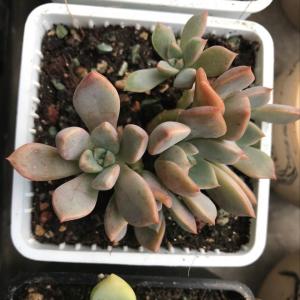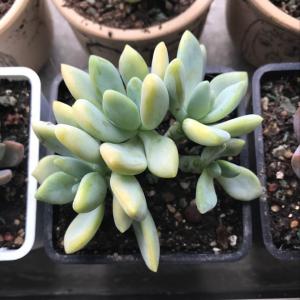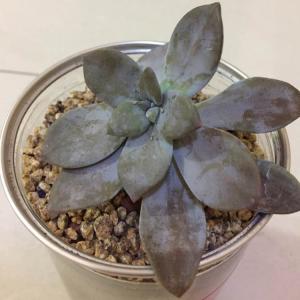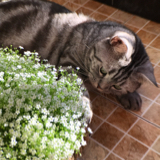文章
权问薇
2017年09月12日

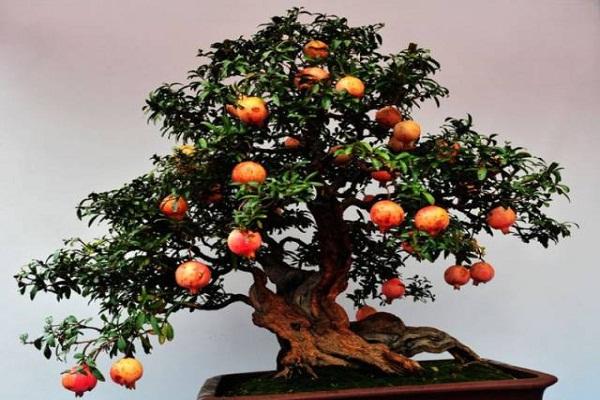
#石榴盆景
转眼到了吃石榴的季节,这次一定要嘴下留情,石榴籽就别往肚子里咽了。你吐出来3颗,这个世界就会多3颗石榴树噢~
1、挑选饱满的石榴种子。

2、在阴凉通风的地方晾干。

3、准备透明珍珠岩育苗盒,将石榴籽剪头,朝上放入珍珠岩育苗盒中。

4、放到自然散射光环境,一天喷1次水,保持湿润,大约2-3周,种子就发芽了!

5、等植株长到5-7cm时,就能看到底部长长的根系,就将植株取出。

6、给小苗喷水,让根部湿润,然后将根系剪短,并抹上生根粉。

(修根前后对比)
7、准备好土壤疏松肥沃的花盆,先用小木棍戳洞,再将幼苗小心上盆。

8、放在通风散光的环境养护,避免阳光直射。

9、大约3个月左右,植株的枝条开始木质化。

10、趁着枝条柔软,准备塑形。用结实的钢丝或者铜丝,从石榴苗的底部开始,螺旋状缠绕。

11、因为刚长起来得树苗柔韧性好,长得也快,很好塑形,慢慢地就会随着钢丝生长,就有了下面这些美美的盆栽。

芒果盆栽
芒果是花花最喜欢的水果啦,好看又好吃。为了能吃到更多芒果,我决定种一棵芒果树~
1、尽量选择大芒果,这样的芒果果核比较大,也更成熟,发芽率也就高喽。

2、把外面黄色的果肉刮掉,洗干净,漏出里面白白的纤维。然后放在通风透气的地方晾干。

3、将外面的皮用剪刀剪掉,把外壳剥开,这样更有利于发芽。

4、剥开就看见褐色种子,小心将种子取出。

5、用小刀小心地将外面的那层薄膜去掉,一定不要刮伤种子,要不然种子就不发芽了。然后泡在水里,每天换水。

6、大约4天左右,种子就发芽了。在这个过程中,种子会由黄白色转为淡淡的黄绿色。

7、选择一个是芒果长度两倍高度的花盆,在土表喷水至潮湿,然后挖一个洞,把种子嫩芽朝上,竖着放进去,朝上部分要稍微露一点出来。

8、土表铺上薄薄的小石子,浇透水,放到有散射光的地方,记得两天喷水一次哦!

9、现在的季节,一周左右就能抽出嫩芽来,而且长得非常快。

10、慢慢的,一棵小芒果树就形成了~

火龙果盆栽
火龙果的种子最多了,随随便便就能取出很多哦~
1、把火龙果切开,挖出一半果肉。

2、和水一起,放容器里,搅拌。

3、浸泡2天,将果肉和种子分离,用细纱布沥干水分。

4、选取最细的漏勺,放在阴凉处,晾几天直到干燥。

5、找一个你喜欢的容器,底部铺一层洗干净的小石子。

6、装土,细沙、蛭石在加园土就可以了。
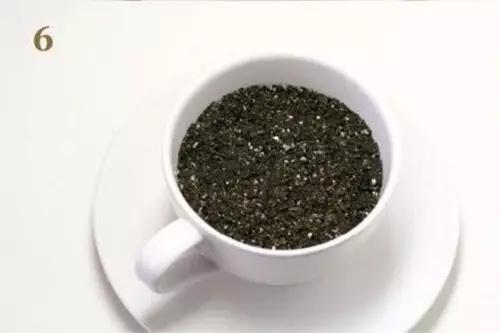
7、想要一个特别的造型吗,还可以准备各种形状模具。

8、模具外围撒一层漂亮整洁的白色沙子。

9、将种子撒到模具内部的土壤表面。

10、喷水湿润,覆盖保鲜膜保湿保温。
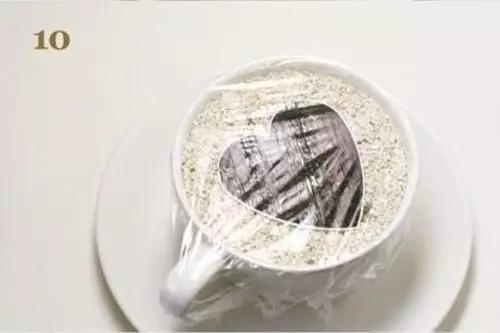
11、放到散光环境,用不了一周,它就发芽了。

12、两周的样子,真的是超级可爱。

13、再长大一点还会有柔软的小刺,毛茸茸的。一盆火龙果盆栽就做好啦。

山竹
山竹用来种盆栽也很可爱哦,快来学学~
1、把山竹肉吃完后,种子留出来洗干净,放在小碟子里泡着,8天左右,每天换水。

2、把山竹种子浅浅埋在育苗土里,等待发芽,一定要耐心哦,不要挖出来看,那样会不长的。

3、10天左右,山竹果核就长出了红色的根,白色的芽。

4、将山竹果核埋进土里,注意哦,嫩芽要朝上,根要朝下的,然后铺上一层薄薄的麦饭石,浇透水。

5、很快,山竹的茎就冒出来啦,只要一天,叶子就舒展开来。

6、不出两周,叶子就变色了,由红色转为黄色,又转为绿色。

7、大约5个月后,山竹就长美美的大盆栽啦!漂亮吧?

4
7
🦄Nana🌸
2017年09月09日

10月9日种的小多肉们 上盆步骤:这个详情
1.种下3天后再浇水,浇湿土壤表面即可(刚种下浇太多水根系也吸收不了营养,长时间水份得不挥发很容易烂根)
2.后期浇水是土壤干透再浇透,不干透不浇(浇透为指的是浇至底部排水孔流水为止,夏天浇水最好的时间段为傍晚和晚上,冬天则为白天浇水最好)
3、正常浇透一次大概需要10-15天左右会干透(具体看各地气候和土壤保水性,如果光照不足阴雨天则更需拉长浇水间隔)
Ps:如果不懂得土是否干透了,在土内插一支牙签,2小时后拔出没有水汽现象就干透了,这样重复几次,自然也可以掌握浇水的规律和时间,以后没有竹签也不担心了。
日照问题:
多肉基本上都是喜阳的,它们都符合一个原则,越晒越美丽(温差大的环境里)平均日照时间超过5小时最佳(夏天避免暴晒)
1.已进入秋冬天了(28度以下的温度)是可以全日照的。
2.夏天尽量避免暴晒(避免晒大中午的日照或者可以晒下午4点以后的阳光,然后足部增强光照)服盆之后春秋冬季就尽量多晒!!



1.种下3天后再浇水,浇湿土壤表面即可(刚种下浇太多水根系也吸收不了营养,长时间水份得不挥发很容易烂根)
2.后期浇水是土壤干透再浇透,不干透不浇(浇透为指的是浇至底部排水孔流水为止,夏天浇水最好的时间段为傍晚和晚上,冬天则为白天浇水最好)
3、正常浇透一次大概需要10-15天左右会干透(具体看各地气候和土壤保水性,如果光照不足阴雨天则更需拉长浇水间隔)
Ps:如果不懂得土是否干透了,在土内插一支牙签,2小时后拔出没有水汽现象就干透了,这样重复几次,自然也可以掌握浇水的规律和时间,以后没有竹签也不担心了。
日照问题:
多肉基本上都是喜阳的,它们都符合一个原则,越晒越美丽(温差大的环境里)平均日照时间超过5小时最佳(夏天避免暴晒)
1.已进入秋冬天了(28度以下的温度)是可以全日照的。
2.夏天尽量避免暴晒(避免晒大中午的日照或者可以晒下午4点以后的阳光,然后足部增强光照)服盆之后春秋冬季就尽量多晒!!



0
0
文章
权问薇
2017年09月03日

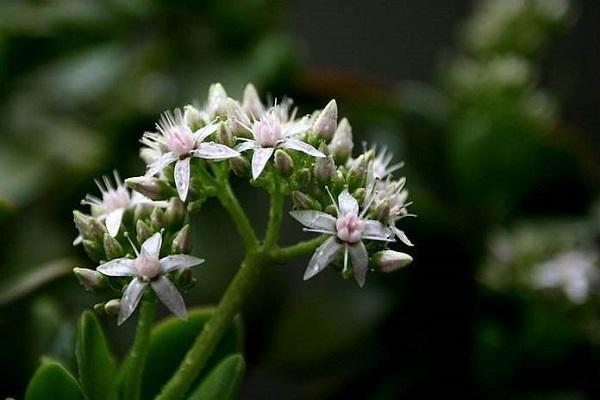
#玉树 施肥方式
基肥:在种植前或是换盆换土时,要把基肥施足,有条件的可以用腐熟的有机肥;
生长期:生长期施肥属于追肥,每个月要进行2次至3次施肥,肥料最好是腐熟稀薄的饼液肥;
春季:约10天至15天施一次肥,但要每隔3天浇一次水;
夏季:夏季温度比较高,玉树也会进入半休眠期,此时不适宜施肥;
秋季:严格来说从天气开始转凉起,就要恢复正常的施肥,施肥方法与春季相同,此时的玉树也会彻底苏醒;
冬季:其实是从霜降来临时到整个冬季都要暂停施肥。

注意事项
想要保持玉树的观赏性,在修剪过后就不宜施肥过重,否则会引起玉树的徒长。
若在春季进行换盆换土施肥后,要把玉树移到阳光可以直接照晒进来的地方放置。
以上便是玉树的养护中肥料的施放方法与注意事项,希望对养殖玉树的友友们有所帮助。玉树的观赏价值很高,效果也很好,若友友们想入手一盆盆栽来观赏用,可以优先考虑一下玉树。
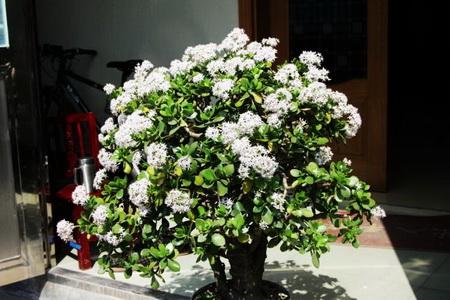
3
6
L -:我冬天买的玉树,换的盆,没有浇透水,怕烂根
文章
Miss Chen
2017年09月03日

La Tormentilla (Potentilla erecta (L.) Rauschel) es una hierba anual de la familia de lasRosáceas, con tallos en forma de horquillas y de alrededor 20 cm. de longitud, hojas verdes compuestas de 3 o 7 hojuelas ovales, dentadas en el margen y algo vellosas por el envés; flores amarillas con cuatro pétalos, axilares y solitarias, fruto seco y rizoma rojizo.

PARTES UTILIZADAS DE LA TORMENTILLA:
PRINCIPIOS ACTIVOS DE LA TORMENTILLA:
Abundantes taninos catéquicos (15-20%), que durante el proceso de secado y almacenamiento se van convirtiendo en flobafenos; flavantrioles y procianidinas; taninos elágicos (6,2%): elagitanino, ácidos gálico y elágico libres. Pseudosaponósido: tormentósido; ácido quinóvico; ácidos fenil-carboxílicos: caféico, p-cumarínico, sinápico. Resina, goma, trazas de aceite esencial.
EFECTOS DE LA TORMENTILLA:
Por su riqueza en taninos es una buena droga astringente: antidiarréico, hemostático local, cicatrizante. Además se han evidenciado sus efectos como antiinflamatorio, antibacteriano, antialergénico, antihipertensivo, inmunoestimulante y antiviral.
INDICACIONES DE LA TORMENTILLA:
Cólicos intestinales, diarreas, prevención y tratamiento de síndromes gripales y resfriados, coadyuvante en el tratamiento de la hipertensión arterial. Hemorroides, fragilidad capilar, hemorragias uterinas funcionales, varices.
En uso tópico: heridas, quemaduras, estomatitis, glositis, parodontopatías, faringitis, fisuras anales, ulceraciones dérmicas y corneales, conjuntivitis, dermatitis, problemas bucales, eritemas, estrías, prurito, vulvovaginitis, hemorragias postafeitado (loción) y nasales.
CONTRAINDICACIONES DE LA TORMENTILLA:
Dispepsias hiposecretoras.
No prescribir formas de dosificación orales con contenido alcohólico a niños menores de dos años ni a consultantes en proceso de deshabituación etílica.
EFECTO TÓXICO DE LA TORMENTILLA:
Por su abundancia en taninos, podría resultar irritante de la mucosa gástrica. Para evitarlo recomendamos combinarla con raíz de malvavisco.
PRECAUCIÓN EFECTO TÓXICO DE LA TORMENTILLA:
Tener en cuenta el contenido alcohólico del extracto fluido y de la tintura.
USO TERAPEÚTICO Y DOSIS DE LA TORMENTILLA:

Uso interno:
* Decocción: 30 g/l, hervir 10 minutos. Tres o cuatro tazas al día.
* Maceración: 5 g/l. Dejar en maceración durante 12 horas. Tomar tres o más tazas al día. Tiene la ventaja de que conserva una mayor proporción de taninos, al no hidrolizarse por la acción del calor.
* Polvo: 2 a 4 g/día, en cápsulas.
* Extracto seco (5:1): 250-500 mg/cápsula. Una a ocho al día.
* Extracto fluido (1:1): 30-50 gotas, una a tres veces al día.
* Tintura (1:10): 50-100 gotas, una a tres veces al día.
Uso externo:
* Maceración o decocción al 5%. Aplicar en forma de lociones, compresas, colutorios, gargarismos o irrigaciones vaginales.

PARTES UTILIZADAS DE LA TORMENTILLA:
PRINCIPIOS ACTIVOS DE LA TORMENTILLA:
Abundantes taninos catéquicos (15-20%), que durante el proceso de secado y almacenamiento se van convirtiendo en flobafenos; flavantrioles y procianidinas; taninos elágicos (6,2%): elagitanino, ácidos gálico y elágico libres. Pseudosaponósido: tormentósido; ácido quinóvico; ácidos fenil-carboxílicos: caféico, p-cumarínico, sinápico. Resina, goma, trazas de aceite esencial.
EFECTOS DE LA TORMENTILLA:
Por su riqueza en taninos es una buena droga astringente: antidiarréico, hemostático local, cicatrizante. Además se han evidenciado sus efectos como antiinflamatorio, antibacteriano, antialergénico, antihipertensivo, inmunoestimulante y antiviral.
INDICACIONES DE LA TORMENTILLA:
Cólicos intestinales, diarreas, prevención y tratamiento de síndromes gripales y resfriados, coadyuvante en el tratamiento de la hipertensión arterial. Hemorroides, fragilidad capilar, hemorragias uterinas funcionales, varices.
En uso tópico: heridas, quemaduras, estomatitis, glositis, parodontopatías, faringitis, fisuras anales, ulceraciones dérmicas y corneales, conjuntivitis, dermatitis, problemas bucales, eritemas, estrías, prurito, vulvovaginitis, hemorragias postafeitado (loción) y nasales.
CONTRAINDICACIONES DE LA TORMENTILLA:
Dispepsias hiposecretoras.
No prescribir formas de dosificación orales con contenido alcohólico a niños menores de dos años ni a consultantes en proceso de deshabituación etílica.
EFECTO TÓXICO DE LA TORMENTILLA:
Por su abundancia en taninos, podría resultar irritante de la mucosa gástrica. Para evitarlo recomendamos combinarla con raíz de malvavisco.
PRECAUCIÓN EFECTO TÓXICO DE LA TORMENTILLA:
Tener en cuenta el contenido alcohólico del extracto fluido y de la tintura.
USO TERAPEÚTICO Y DOSIS DE LA TORMENTILLA:

Uso interno:
* Decocción: 30 g/l, hervir 10 minutos. Tres o cuatro tazas al día.
* Maceración: 5 g/l. Dejar en maceración durante 12 horas. Tomar tres o más tazas al día. Tiene la ventaja de que conserva una mayor proporción de taninos, al no hidrolizarse por la acción del calor.
* Polvo: 2 a 4 g/día, en cápsulas.
* Extracto seco (5:1): 250-500 mg/cápsula. Una a ocho al día.
* Extracto fluido (1:1): 30-50 gotas, una a tres veces al día.
* Tintura (1:10): 50-100 gotas, una a tres veces al día.
Uso externo:
* Maceración o decocción al 5%. Aplicar en forma de lociones, compresas, colutorios, gargarismos o irrigaciones vaginales.
0
0
文章
Dummer. ゛☀
2017年09月02日

Norway spruce (Picea abies) is a tough conifer that makes for an easy-care landscape tree in US Department of Agriculture plant hardiness zones 3 through 7. It is also planted extensively for forest restoration and windbreaks. Planting a Norway spruce is easy because it competes well with grass and weeds and requires no site preparation. Read on for more information about care of Norway spruce trees.
Norway Spruce Tree Info
The Norway spruce tree is native to Europe. However, for over a century it has been planted in this country for both ornamental and utilitarian purposes. The tree roots are strong and the trees can withstand high winds, making them excellent windbreaks. The trees bear stiff evergreen needles up to an inch long, colored a shiny forest green. The bark is a red-brown and furrowed. The seed cones are large, and can grow 6 inches long. They mature in fall.
Norway Spruce Growth
Norway spruce growth is exceptional. The trees grow relatively fast – up to 2 feet a year – and their crowns develop a pyramid shape. The branches may drupe slightly at the tips, giving the trees a graceful allure. If you are thinking of planting a Norway spruce tree, it is important to understand that the tree can reach 100 feet or more in the wild and live for centuries. Although the tree stays shorter when cultivated, homeowners often underestimate the space the tree takes when mature.
Planting a Norway Spruce Tree
The more Norway spruce tree info you have, the more you will see that planting a Norway spruce tree is a good idea. The tree has many good attributes. First, you won’t need to clear out grasses or work the land to prepare a site for planting a Norway spruce tree. This spruce competes against grasses and weeds, and wins. In addition, the tree is drought tolerant. As a conifer, it can go into shut-down mode when irrigation is lacking. At the same time, it is one evergreen that tolerates wet soil. Plant it in marshy soil and it will thrive. You can plant Norway spruce in sun, shade or partial shade and it grows just the same. It is tolerant of poor soil but also grows in rich, fertile soils. Pest resistant, the trees hardly ever fall victim to insect damage or disease. Deer and rodents leave Norway spruce alone.
Care of Norway Spruce Trees
Required Norway spruce care is minimal. If you plant the tree with sufficient elbow room, you may not have to lift a finger other than providing an occasional drink during dry periods. Unlike many trees, the Norway spruce does not produce suckers. Because of this, the tree is not invasive. Digging out suckers is not part of Norway spruce care.

Norway Spruce Tree Info
The Norway spruce tree is native to Europe. However, for over a century it has been planted in this country for both ornamental and utilitarian purposes. The tree roots are strong and the trees can withstand high winds, making them excellent windbreaks. The trees bear stiff evergreen needles up to an inch long, colored a shiny forest green. The bark is a red-brown and furrowed. The seed cones are large, and can grow 6 inches long. They mature in fall.
Norway Spruce Growth
Norway spruce growth is exceptional. The trees grow relatively fast – up to 2 feet a year – and their crowns develop a pyramid shape. The branches may drupe slightly at the tips, giving the trees a graceful allure. If you are thinking of planting a Norway spruce tree, it is important to understand that the tree can reach 100 feet or more in the wild and live for centuries. Although the tree stays shorter when cultivated, homeowners often underestimate the space the tree takes when mature.

Planting a Norway Spruce Tree
The more Norway spruce tree info you have, the more you will see that planting a Norway spruce tree is a good idea. The tree has many good attributes. First, you won’t need to clear out grasses or work the land to prepare a site for planting a Norway spruce tree. This spruce competes against grasses and weeds, and wins. In addition, the tree is drought tolerant. As a conifer, it can go into shut-down mode when irrigation is lacking. At the same time, it is one evergreen that tolerates wet soil. Plant it in marshy soil and it will thrive. You can plant Norway spruce in sun, shade or partial shade and it grows just the same. It is tolerant of poor soil but also grows in rich, fertile soils. Pest resistant, the trees hardly ever fall victim to insect damage or disease. Deer and rodents leave Norway spruce alone.

Care of Norway Spruce Trees
Required Norway spruce care is minimal. If you plant the tree with sufficient elbow room, you may not have to lift a finger other than providing an occasional drink during dry periods. Unlike many trees, the Norway spruce does not produce suckers. Because of this, the tree is not invasive. Digging out suckers is not part of Norway spruce care.
0
0
文章
Colour_
2017年09月01日
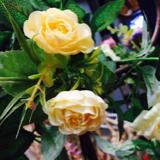
金凤花(学名:Caesalpinia pulcherrima (L.) Sw.):大灌木或小乔木;高达3米,枝绿或粉绿色,有疏刺。二回羽状复叶4对至8对,对生,小叶7对至11对,长椭圆形或倒卵形,基部歪斜,顶端凹缺,小叶柄很短。总状花序顶生或腋生,花瓣圆形具柄, 橙或黄色,花梗长达7厘米。荚果黑色。种子6颗至9颗。花果期几乎全年。
原产地西印度群岛,中国云南、广西、广东和台湾均有栽培。为热带地区有价值的观赏树木之一。
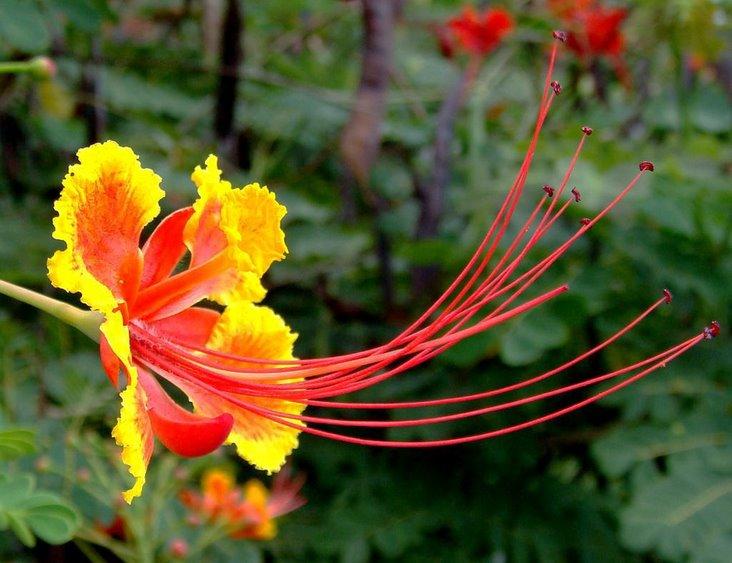

金凤花的繁殖方式
金凤花是用种子繁殖,从6月中旬至12月中旬,荚果陆续成熟,以9-10月份为成熟盛期,采集盛期成熟的果荚,置日光下暴晒,开裂后脱出种子,可以随采随播种,幼苗防寒越冬,也可将种子储藏翌年春播,种子千粒重约132克,发芽时气温需在20℃以上,以春季3月中下旬播种较宜,播前用60℃温水浸种,冷却后继续浸泡12小时,发芽快速,一般播种后三天即开始发芽,一周内发芽结束,发芽率约为60%。
用条播法,幼苗生长速度中等,苗期施氮肥2-3次追苗,10月份以后,停施氮肥,施钾肥一致,促使早期木质化,冬季注意覆盖防霜,1年生苗可出圃定植,2年生幼树,即可开花供观赏。如发生叶斑病,可用50%多菌灵可湿性粉500倍液防治。
金凤花的栽培技术
对肥力的要求不甚高,一般肥力中等、磷钾肥较高的土壤,开花繁茂,色泽亦鲜艳,水分充足,氮肥较高的土壤枝叶繁茂,开花亦较多,但色泽欠鲜艳,种植时宜施腐熟饼肥或垃圾作基肥,花前及开花盛期,追施磷钾肥,树形不甚美观,但具萌芽性,管理中可用截干或修枝整形,促使树冠丰满,也可3-5株种植于一处,以提高观赏效果。
病虫防治
白粉病
症状此病主要发生在叶片和嫩梢上。一般在6月开始发生,7月份以后叶面布满白色粉层。随后,在白粉层中形成黄色小粒点,颜色逐渐变深,最后呈黑褐色。传染途径病菌在病株残体和种子内越冬。翌年,当环境适宜时,病菌借风雨传播。8-9月为发病盛期。
防治方法:
栽植不过密,适当通风,加强肥水管理,增强植株的抗病力。将病叶、病株清除,集中销毁,减少传染源。
发病期间用15%粉锈宁可湿性粉剂1000-1200倍液,或70%甲基托布津可湿性粉剂1000倍液防治。在32℃以上的高温下避免喷药,以免发生药害。
褐斑病
金凤花褐斑病又称风仙花叶斑病,在中国南北各地均有发生。症状病害主要发生在叶片上。叶面病斑初为浅黄褐色小点,后扩展成圆形或椭圆形,以后中央变成淡褐色,边缘褐色,具有不明显的轮纹。严重患病的叶片上,病斑连片,导致叶片变得枯黄,直至植株死亡。传染途径病菌在风仙花病残体及土壤植物碎片上越冬。翌年当环境条件适宜时,病菌借风雨飞散传播。高温多雨的季节,易发病。
防治方法:
金凤花喜肥沃的砂质壤土,不耐涝。因此,种植以砂质壤土为宜,以利排水;盆栽金凤花,雨后应及时倒盆。秋末应将病叶、病株集中销毁,减少来年传染源。
发病初期用25%多菌灵可湿性粉剂300-600倍液,或50%甲基托布津100倍液,或75%百菌清1000倍液防治。
立枯病
症状病菌主要侵染根茎部,致病部变黑或缢缩,潮湿时其上生白色霉状物,植株染病后,数天内即见叶萎蔫、干枯,继而造成整株死亡。
传播途径:主要以菌丝或菌核的形式在土壤或病残体内越冬,土壤中的菌丝营腐生生活,不休眠。在田间,主要靠接触传染,即植株的根、茎、叶接触病土时,便会被土中的菌丝侵染,在有水膜的条件下,与病部接触的健叶即染病。此外,种子、农具及带菌堆肥等都可使病害传播蔓延。
防治方法:在发病初期拔除病株后喷洒75%百菌清可湿性粉剂600倍液,或60%多·福可湿性粉剂500倍液、20%甲基立枯磷乳油1200倍液。
原产地西印度群岛,中国云南、广西、广东和台湾均有栽培。为热带地区有价值的观赏树木之一。


金凤花的繁殖方式
金凤花是用种子繁殖,从6月中旬至12月中旬,荚果陆续成熟,以9-10月份为成熟盛期,采集盛期成熟的果荚,置日光下暴晒,开裂后脱出种子,可以随采随播种,幼苗防寒越冬,也可将种子储藏翌年春播,种子千粒重约132克,发芽时气温需在20℃以上,以春季3月中下旬播种较宜,播前用60℃温水浸种,冷却后继续浸泡12小时,发芽快速,一般播种后三天即开始发芽,一周内发芽结束,发芽率约为60%。
用条播法,幼苗生长速度中等,苗期施氮肥2-3次追苗,10月份以后,停施氮肥,施钾肥一致,促使早期木质化,冬季注意覆盖防霜,1年生苗可出圃定植,2年生幼树,即可开花供观赏。如发生叶斑病,可用50%多菌灵可湿性粉500倍液防治。
金凤花的栽培技术
对肥力的要求不甚高,一般肥力中等、磷钾肥较高的土壤,开花繁茂,色泽亦鲜艳,水分充足,氮肥较高的土壤枝叶繁茂,开花亦较多,但色泽欠鲜艳,种植时宜施腐熟饼肥或垃圾作基肥,花前及开花盛期,追施磷钾肥,树形不甚美观,但具萌芽性,管理中可用截干或修枝整形,促使树冠丰满,也可3-5株种植于一处,以提高观赏效果。
病虫防治
白粉病
症状此病主要发生在叶片和嫩梢上。一般在6月开始发生,7月份以后叶面布满白色粉层。随后,在白粉层中形成黄色小粒点,颜色逐渐变深,最后呈黑褐色。传染途径病菌在病株残体和种子内越冬。翌年,当环境适宜时,病菌借风雨传播。8-9月为发病盛期。
防治方法:
栽植不过密,适当通风,加强肥水管理,增强植株的抗病力。将病叶、病株清除,集中销毁,减少传染源。
发病期间用15%粉锈宁可湿性粉剂1000-1200倍液,或70%甲基托布津可湿性粉剂1000倍液防治。在32℃以上的高温下避免喷药,以免发生药害。
褐斑病
金凤花褐斑病又称风仙花叶斑病,在中国南北各地均有发生。症状病害主要发生在叶片上。叶面病斑初为浅黄褐色小点,后扩展成圆形或椭圆形,以后中央变成淡褐色,边缘褐色,具有不明显的轮纹。严重患病的叶片上,病斑连片,导致叶片变得枯黄,直至植株死亡。传染途径病菌在风仙花病残体及土壤植物碎片上越冬。翌年当环境条件适宜时,病菌借风雨飞散传播。高温多雨的季节,易发病。
防治方法:
金凤花喜肥沃的砂质壤土,不耐涝。因此,种植以砂质壤土为宜,以利排水;盆栽金凤花,雨后应及时倒盆。秋末应将病叶、病株集中销毁,减少来年传染源。
发病初期用25%多菌灵可湿性粉剂300-600倍液,或50%甲基托布津100倍液,或75%百菌清1000倍液防治。
立枯病
症状病菌主要侵染根茎部,致病部变黑或缢缩,潮湿时其上生白色霉状物,植株染病后,数天内即见叶萎蔫、干枯,继而造成整株死亡。
传播途径:主要以菌丝或菌核的形式在土壤或病残体内越冬,土壤中的菌丝营腐生生活,不休眠。在田间,主要靠接触传染,即植株的根、茎、叶接触病土时,便会被土中的菌丝侵染,在有水膜的条件下,与病部接触的健叶即染病。此外,种子、农具及带菌堆肥等都可使病害传播蔓延。
防治方法:在发病初期拔除病株后喷洒75%百菌清可湿性粉剂600倍液,或60%多·福可湿性粉剂500倍液、20%甲基立枯磷乳油1200倍液。
0
1
文章
权问薇
2017年09月01日

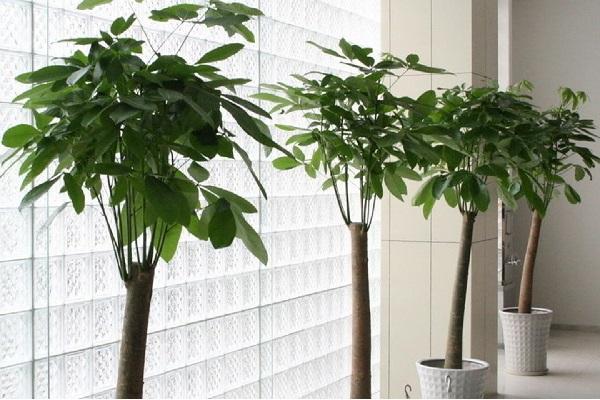
发财树长白斑的原因
1、虫害导致,若出现虫害现象,可以从叶片的前面发现害虫的粪便等排泄物。主要虫害有红蜘蛛、介壳虫等;
2、温度过度,加上叶面有水,会产生冻斑;
3、夏季通风较差在加上特有的潮湿闷热环境也会引发一些病虫害;
4、浇水过多。

发财树长白斑的防治方法
1、要保持土壤的透气性与疏松度,最好是选择较为肥沃的且土质为沙质干净土壤。
2、浇水要合理,不要超量,从而造成积水现象。
3、夏季温度极高时,要注意适当的通风。
4、要经常观察植物,发现病虫害,要及时把受迫害的地方摘除,严重时可用药物喷杀。
5、冬季要注意保温防寒,不要在温度较低时向植物表面喷水,否则很容易引起冻伤。
6、可以用酒精(不可以用喝的白酒代替)对其叶子进行洗刷,用溶解后的洗衣粉水对其叶子进行洗刷也可以,但要小心,不要让洗衣粉水滴进土壤里,会影响植物正常生长。
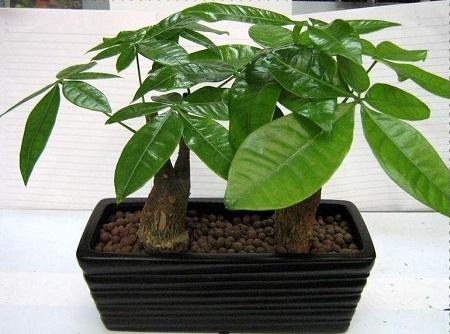
0
1



